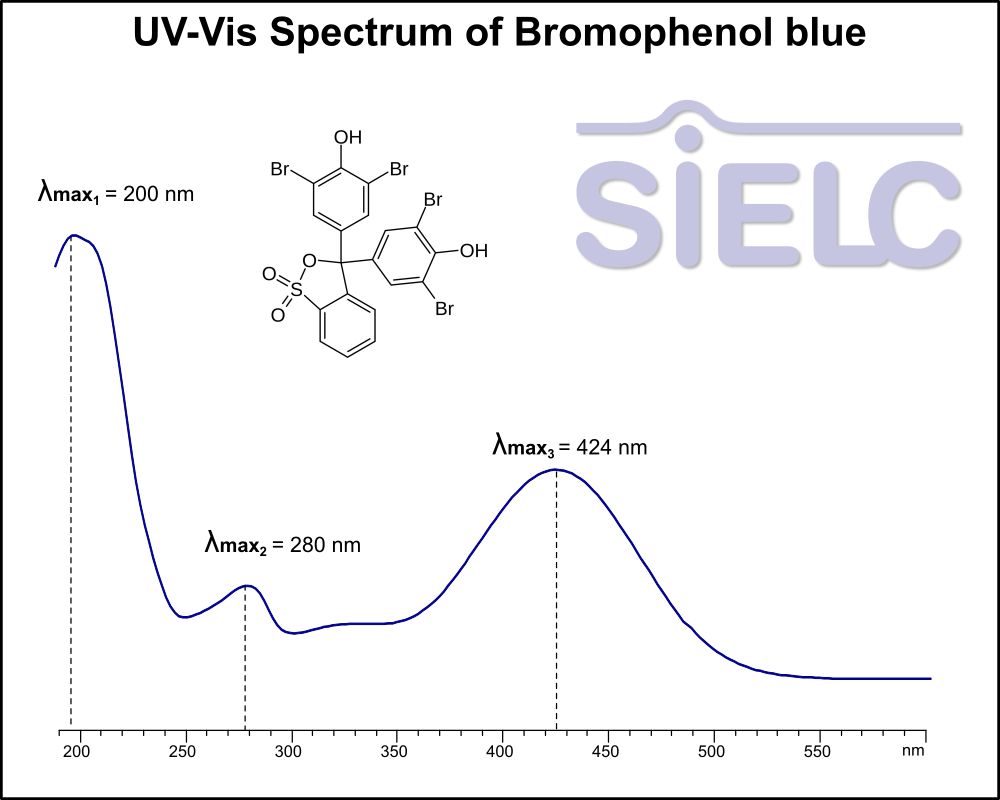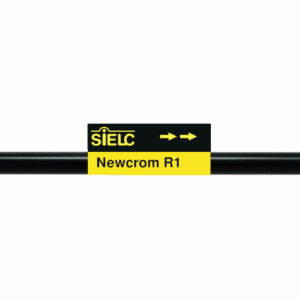| CAS Number | 115-39-9 |
|---|---|
| Molecular Formula | C19H10Br4O5S |
| Molecular Weight | 669.961 |
| InChI Key | UDSAIICHUKSCKT-UHFFFAOYSA-N |
| LogP | 5.77 |
| Synonyms |
|
Applications:
UV-Vis Spectrum of Bromophenol blue
March 11, 2025

For optimal results in HPLC analysis, it is recommended to measure absorbance at a wavelength that matches the absorption maximum of the compound(s) being analyzed. The UV spectrum shown can assist in selecting an appropriate wavelength for your analysis. Please note that certain mobile phases and buffers may block wavelengths below 230 nm, rendering absorbance measurement at these wavelengths ineffective. If detection below 230 nm is required, it is recommended to use acetonitrile and water as low UV-transparent mobile phases, with phosphoric acid and its salts, sulfuric acid, and TFA as buffers.
For some compounds, the UV-Vis Spectrum is affected by the pH of the mobile phase. The spectra presented here are measured with an acidic mobile phase that has a pH of 3 or lower.

HPLC Method for Analysis of Bromophenol blue on Newcrom R1 Column
March 11, 2025
HPLC Method for Bromophenol blue on Newcrom R1 by SIELC Technologies

High Performance Liquid Chromatography (HPLC) Method for Analysis of Bromophenol blue
Bromophenol blue (BPB) is a pH indicator and dye commonly used in laboratories, especially in gel electrophoresis and titrations.
pH Indicator Properties
Color Changes:
Below pH 3.0: Yellow
Between pH 3.0 and 4.6: Greenish
Above pH 4.6: Blue
Bromophenol blue can be retained and analyzed using the Newcrom R1 column. The analysis utilizes an isocratic method with a simple mobile phase consisting of water, acetonitrile (MeCN), and sulfuric acid as a buffer. Detection is carried out using UV.
You can find detailed UV spectra of Bromophenol blue and information about its various lambda maxima by visiting the following link.
| Column | Newcrom R1, 3.2 x 100 mm, 5 µm, 100 A, dual ended |
| Mobile Phase* | Gradient MeCN – 30-70%, 10 min |
| Buffer | H2SO4 – 0.2% |
| Flow Rate | 0.5 ml/min |
| Detection | VIS 420, (λmax-200, 280, 424nm) |
| LOD** | 2 ppb |
*To make the mobile phase
| First prepare 1% H2SO4 stock solution in H2O. For A, combine 200mL of stock solution with 300mL of ACN and 500mL of H2O –> 30/70/0.2 ACN/H2O/H2SO4. For B, combine 200mL of stock solution with 700mL of ACN and 100mL of H2O –> 70/30/0.2 ACN/H2O/H2SO4. Then you can run the method from 100% A to 100%B in 10 minutes. |
**LOD was determined for this combination of instrument, method, and analyte, and it can vary from one laboratory to another even when the same general type of analysis is being performed.
| Class of Compounds | Dye |
| Analyzing Compounds | Bromophenol blue |
Application Column
Newcrom R1
Column Diameter: 3.2 mm
Column Length: 100 mm
Particle Size: 5 µm
Pore Size: 100 A
Column options: dual ended

Separation of Bromophenol blue on Newcrom R1 HPLC column
February 16, 2018
Bromophenol blue can be analyzed by this reverse phase (RP) HPLC method with simple conditions. The mobile phase contains an acetonitrile (MeCN), water, and phosphoric acid. For Mass-Spec (MS) compatible applications the phosphoric acid needs to be replaced with formic acid. Smaller 3 µm particles columns available for fast UPLC applications. This liquid chromatography method is scalable and can be used for isolation impurities in preparative separation. It also suitable for pharmacokinetics.
Application Column
Newcrom R1
The Newcrom columns are a family of reverse-phase-based columns. Newcrom A, AH, B, and BH are all mixed-mode columns with either positive or negative ion-pairing groups attached to either short (25 Å) or long (100 Å) ligand chains. Newcrom R1 is a special reverse-phase column with low silanol activity.
Select options


